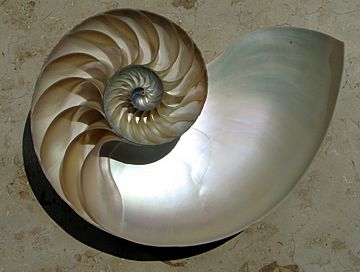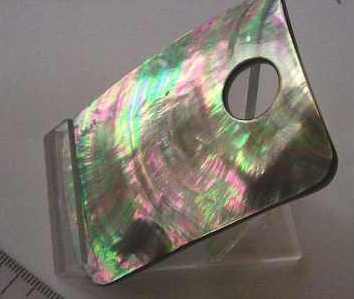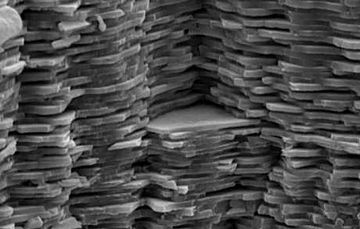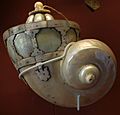Nacre facts for kids

Nacre (say "NAY-ker"), also known as mother of pearl, is a special material made by some molluscs. It forms the shiny inner layer of their seashells. Pearls are also made of nacre! It's a very strong, flexible, and shimmering material.
You can find nacre in some of the oldest types of molluscs, like certain bivalves (clams, oysters), gastropods (snails), and cephalopods (like nautiluses). However, most mollusc shells have a porcelain-like inner layer, which isn't as shimmery as nacre.
The outer part of cultured pearls and the inside of pearl oyster shells are made of nacre. Other sea snails like abalones and turban snails also have a nacreous inner shell.
Contents
What is Nacre Like?
How Nacre Looks and is Built
Nacre is made of tiny, flat, six-sided pieces called platelets. These platelets are made of aragonite, which is a type of calcium carbonate (like chalk). They are very thin, about 0.5 micrometers thick, and are stacked up like tiny bricks.
Between these aragonite "bricks" are thin layers of stretchy natural materials. These include things like chitin and special proteins.
Nacre looks shimmery because of how thin these aragonite platelets are. Their thickness is similar to the size of visible light waves. This causes light to bounce and mix in a way that creates beautiful, changing colors, depending on how you look at it.
How Strong is Nacre?
The mix of hard aragonite platelets and thin, stretchy protein layers makes nacre very strong and tough. It's almost as strong as silicon. This "brickwork" design helps stop cracks from spreading through the material.
Scientists study nacre to understand how it gets its strength. They use different tests to see how it handles pushing, pulling, and twisting forces. They also try to create new materials that are as strong as nacre by copying its natural design.
When nacre dries out, it loses a lot of its strength and becomes brittle, like pure aragonite. Water helps keep the stretchy layers flexible, which makes the nacre tougher.
How Nacre Forms
Scientists are still learning exactly how nacre forms. They've seen that it starts with tiny particles that group together inside a mollusc's shell. These particles line up and multiply, eventually forming the early layers of nacre.
Each tiny "brick" of nacre grows quickly until it meets the other bricks around it. This creates the tightly packed, six-sided pattern that nacre is known for. The mollusc uses special organic substances to control when and how these nacre crystals start and grow.
Nacre is different from another similar mineral called fibrous aragonite because of how fast it grows in a certain direction. Nacre grows slowly in this direction, which helps make it strong.
Scientists have also found tiny spiral flaws in the first layers of nacre. As more layers are added, these flaws merge and disappear, making the later layers of nacre very smooth and organized.
What Nacre Does for Molluscs

Nacre is made by special cells in the mantle tissue of molluscs. The mollusc continuously adds layers of nacre to the inside of its shell. This shiny inner layer is what we call "mother of pearl."
These layers of nacre make the shell surface smooth. They also help protect the soft body of the mollusc from parasites and harmful bits of dirt. If something gets inside the shell, the mollusc covers it with layers of nacre. This forms either a blister pearl attached to the shell or a free pearl inside the mollusc's soft tissues. This process continues as long as the mollusc lives.
Where Does Nacre Come From?
The main places we get mother of pearl for commercial use are from pearl oysters and freshwater pearl mussels. Abalone shells are also used. These shells were very popular in the late 1800s for their strength and beauty.
In the 1900s, shells from large green turban snails and top snails were widely used to make pearl buttons. The international trade of mother of pearl is controlled by an agreement called CITES, which helps protect endangered animals and plants.
How Nacre is Used
Decorative Uses
Nacre in Buildings
Both dark and light nacre are used in architectural designs. Natural nacre can be colored almost any shade. Small pieces of nacre, called tesserae, can be cut into shapes and glued onto ceramic tile or marble bases. These pieces are placed by hand to create unique patterns.
The nacre material is usually about 2 millimeters (0.08 inches) thick. It's then coated with lacquer and polished to create a strong, shiny surface. Instead of a tile base, nacre tesserae can also be glued to fiberglass. This makes a lighter material that can be installed without visible seams. Nacre sheets can be used on floors, walls, countertops, doors, and ceilings inside buildings.
Nacre in Musical Instruments
Nacre is often used for keys and other decorations on musical instruments. Many accordions and concertinas are completely covered in nacre. Some guitars have nacre inlays on their fingerboards or headstocks.
Greek instruments like the bouzouki often have nacre decorations. The oud, a Middle Eastern instrument, also features nacre around its sound holes. The bows of stringed instruments like the violin and cello often have mother of pearl on the frog (the part you hold). Nacre is also traditionally used on saxophone keytouches and the valve buttons of trumpets. The Middle Eastern goblet drum (darbuka) is also commonly decorated with mother of pearl.
Other Decorative Uses
Mother of pearl buttons are used on clothing for both practical and decorative reasons. The Pearly Kings and Queens in London are famous for their outfits covered in mother of pearl buttons.
Nacre is sometimes used for the decorative handles of firearms. It's also used to make special spoons for eating caviar, because it doesn't change the taste like metal spoons can.
Biomedical Uses
A company called Marine Biomedical is working on a product called "PearlBone" made from nacre. This product could be used for patients who need bone grafting and reconstructive surgery. They hope it will be approved for use around 2024–2025. The plan is to build a factory in the Kimberley region of Australia, where pearl shells are common, to grind nacre into a form suitable for medical use. In the future, it might even be used for dental fillings and spinal surgery.
Man-Made Nacre
Scientists have been able to create calcium-based nacre in the lab by copying how it grows naturally.
In 2014, researchers used lasers to make a material similar to nacre by engraving tiny, wavy "micro-cracks" in glass. When this treated glass was hit, the micro-cracks absorbed and spread out the energy, stopping the glass from shattering. This treated glass was reportedly 200 times tougher than regular glass!
See also
 In Spanish: Nácar para niños
In Spanish: Nácar para niños
- Ammolite
- Pearling in Western Australia
- Raden
Images for kids
-
An Altarpiece from around 1520, with lots of carved nacre
-
Inlay with nacre tesserae at Topkapı Palace in Istanbul
-
An engraved nacre pendant from the Solomon Islands, 1838









